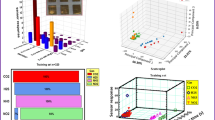Abstract
Odorous air samples collected from several sources were presented to an olfactometer, an electronic nose, a hydrogen sulfide (H2S) detector and an ammonia (NH3) detector. The olfactometry measurements were used as the expected values while measurements from the other instrumentation values became input variables. Five hypotheses were established to relate the input variables and the expected values. Both linear regression and artificial neural network analyses were used to test the hypotheses. Principal component analysis was utilized to reduce the dimensionality of the electronic nose measurements from 33 to 3 without significant loss of information. The electronic nose or the H2S detector can individually predict odor concentration measurements with similar accuracy (R 2 = 0.46 and 0.50, respectively). Although the NH3 detector alone has a very poor relationship with odor concentration measurements, combining the H2S and NH3 detectors can predict odor concentrations more accurately (R 2 = 0.58) than either individual instrument. Data from the integration of the electronic nose, H2S, and NH3 detectors produce the best prediction of odor concentrations (R 2 = 0.75). With this accuracy, odor concentration measurements can be confidently represented by integrating an electronic nose, and H2S and NH3 detectors.
Similar content being viewed by others
References
AromaScan (1995). AromaScan A32S User’s Manual. AromaScan pic. Electra House, Electra Way, Crewe, UK
CEN (2003). Air quality – Determination of odour concentration by dynamic olfactometry. Brussels, Belgium: European Community for Standardization Central Secretariat (EN 13725).
Feddes, J. J. R., Qu, G., Oullette, C. A., & Leonard, J. J. (2001). Development of an eight-panellist single port, forced-choice, dynamic dilution olfactometer. Canadian Biosystems Engineering, 43, 6.1–6.5.
Frederick, M. (1996). NeuroShell-2 reference manual. Ward Systems Group Inc.
Goodner, K. L., Dreher, J. G., & Rouseff, R. L. (2001). The dangers of creating false classifications due to noise in electronic nose and similar multivariate analyses. Sensors and Actuators B: Chemical, 80(3), 261–266.
Gralapp, A. K., Powers, W. J., & Bundy, D. S. (2001). Comparison of olfactometry, gas chromatography and electronic nose technology for measurement of indoor air from swine facilities. Transactions of the ASAE, 44(5), 1283–1290.
Hanumantharaya, U., Leis, J., & Hancock, N. (1999). Quantitative odor modeling using electronic nose information. In Fifth International Symposium on Signal Processing and its Applications (ISSPA 99). Brisbane, Australia.
Hobbs, P. J., Misselbrook, T. H., Dhanoa, M. S., & Persaud, K. C. (2000). Relationship between olfactory response and major odorants from livestock wastes. In Proceedings of the 2nd International Conference on Air Pollution Agricultural Operations, Des Moines, Iowa.
Jackson, J. E. (1991). A user’s guide to principal components. New York: Wiley.
Misselbrook, T. H., Hobbs, P. J., & Persaud, K. C. (1997). Use of an electronic nose to measure odor concentration following application of cattle slurry to grassland. Journal of Agricultural Engineering Research, 66(3), 213–220.
Persaud, K. C., Khaffaf, S. M., Hobbs, P. J., Misselbrook, T. H., & Sneath, R. W. (1996). Application of conducting polymer odor sensing arrays to agricultural malodor monitoring. First international conference on air pollution from agricultural operations. Midwest Plan Service (pp. 249–253). Ames, IA: Iowa State University.
Powers, W. (2003). Characterization of air in and around poultry and livestock facilities. Gaseous and Odor Emissions from Animal Production Facilities. Horsens, Denmark.
Qu, G., Feddes, J. J. R., Armstrong, W. W., Leonard, J. J., & Coleman, R. N. (1999). Combining an electronic nose with an artificial neural network to measure odor concentration. ASAE/CSAE-SCGR Annual International Meeting, Paper No.993203, Toronto, Canada.
Qu, G., Feddes, J. J. R., Armstrong, W. W., Coleman, R. N., & Leonard, J. J. (2001). Measuring odor concentration with an electronic nose. Transactions of the ASAE, 44(6), 1807–1812.
SAS (2003). SAS OnlineDoc: Documentation for SAS Products and Solutions. http://support.sas.com/documentation/onlinedoc/index.html. Visited on February, 2003.
Stuetz, R. M., Fenner, R. A., & Engin, G. (1999). Assessment of odors from sewage treatment works by an electronic nose, H2S analysis and olfactometry. Water Research, 33(2), 453–461.
Wilson, D. M., Roppel, T., & Kalim, R. (2000). Aggregation of sensory input for robust performance in chemical sensing microsystems. Sensors and Actuators B: Chemical, 64(1–3), 107–117.
Author information
Authors and Affiliations
Corresponding author
Rights and permissions
About this article
Cite this article
Qu, G., Omotoso, M.M., Gamal El-Din, M. et al. Development of an integrated sensor to measure odors. Environ Monit Assess 144, 277–283 (2008). https://doi.org/10.1007/s10661-007-9991-9
Received:
Accepted:
Published:
Issue Date:
DOI: https://doi.org/10.1007/s10661-007-9991-9




